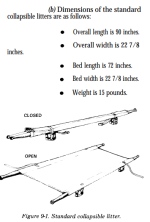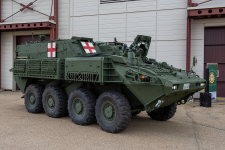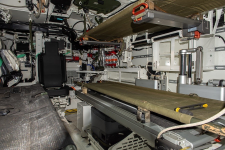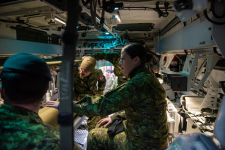- Reaction score
- 3,764
- Points
- 1,160
What will medicine on the battlefield look like?
A few weeks ago @Staff Weenie posted an off-hand question in the logistic vehicle modernization thread that caught my attention and started me thinking (a dangerous development). Thus it led to my opening question. But taking it one bite at a time, what should that ambulance look like?
There were a couple of subsequent posts in response.
Valid contributions, but my initial thought (and I mean no disrespect to your experiences) was "typical uninformed operators who don't know how the medical system works once the casualty leaves their sight". But to be honest, there are probably some BGHs in the RCMS world who also don't know - there certainly were some back decades ago (up to 5 decades) when I worked in the back of 3/4 ton, 5/4 ton, M113, crash amb, road amb, MLVW (no duff in Rwanda) or commanded Unimog, LSVW and Mercedes bus ambulances.
I'll pause momentarily while someone calls me an out of date arsehole.
I perked up when @Staff Weenie raised the issue of R2 to R3 ground evac. In our battle group or brigade group focused army little attention has been paid to the echelons above what we've cobbled together and put into the field (an exception may have been 333 ATC in CFE over 30 years ago). In one of the few official documents I've been able to find online about Canadian operational HSS, Role 1 is the only priority specifically mentioned.
 www.canada.ca
www.canada.ca
Online Canadian references are sparce. One other I did find (from the usual suspects, Homer Tien and Andy Beckett) is two years old, so while it does touch on the evolution in battlefield HSS that is being seen in the Russo-Ukrainian war, it may not be as up to date as other sources.
Medical support for future large-scale combat operations
Their monogram doesn't discuss vehicle evacuation but it does contain a common theme found in other discussions of how things are different - that Ukraine is not Afghanistan.

 militaryhealth.bmj.com
militaryhealth.bmj.com

 www.polska-zbrojna.pl
www.polska-zbrojna.pl
So, what should that ambulance (or whatever ground evacuation assets) look like? As capacity was a factor in Staff Weenie's original post and various increases or limitations in size were mentioned in the couple of responses, what does that vehicle need? Or, maybe the question should be "what should those ambulances look like?"
And while it can be demoralizing when one is told that "size matters", there is truth in that for ambulances as for other more social interactions. One size that matters is:

I've had a few experiences when the interior space was inadequate.
A few weeks ago @Staff Weenie posted an off-hand question in the logistic vehicle modernization thread that caught my attention and started me thinking (a dangerous development). Thus it led to my opening question. But taking it one bite at a time, what should that ambulance look like?
Hmmm, I wonder if Roshel could produce an Ambulance variant for use from R2 to R3, possibly even from R1 to R2? Something that can hold up to four litter patients.
There were a couple of subsequent posts in response.
I suspect they could easily do it, but would need some confirmed orders. My guess looking at the vehicle is they could likley raise the roof by 6" to possibly a 1' without any major changes to the vehicle or body. There is likley a point where the higher armour structure starts requiring a major redesign and weight distribution, suspension changes. I suspect they likley have a good idea where that point is at.
I’m real torn on roles you mention. I see it as ‘a little bit pregnant’.
1) I don’t think it fits the bill for a CP - as in a heavy or medium unit that is a LAV or the MSV SMP for Bde. For a light unit, it’s too big and bulky, and the ideal of a light vehicle Box CP is counter to the general doctrine for light forces — at least at the unit level. Yeah I’m not a fan of Arty units doing it either for Bty or Reg’t CP’s for a bunch of reasons.
2) Same sort of thought goes to the Ambulance role. It should be a LAV for the LAV entities. For light units - you’re more looking at an evac vehicle so the MRZR or ISV are probably better in that way - as they have vastly better mobility.
Honestly if the CA properly equipped all of its units - the idea of something like this would be relegated to the trash or as an emergency interim option for national mobilization.
Valid contributions, but my initial thought (and I mean no disrespect to your experiences) was "typical uninformed operators who don't know how the medical system works once the casualty leaves their sight". But to be honest, there are probably some BGHs in the RCMS world who also don't know - there certainly were some back decades ago (up to 5 decades) when I worked in the back of 3/4 ton, 5/4 ton, M113, crash amb, road amb, MLVW (no duff in Rwanda) or commanded Unimog, LSVW and Mercedes bus ambulances.
I'll pause momentarily while someone calls me an out of date arsehole.
I perked up when @Staff Weenie raised the issue of R2 to R3 ground evac. In our battle group or brigade group focused army little attention has been paid to the echelons above what we've cobbled together and put into the field (an exception may have been 333 ATC in CFE over 30 years ago). In one of the few official documents I've been able to find online about Canadian operational HSS, Role 1 is the only priority specifically mentioned.
Health Services Modernization - Modern and Ready: A Vision for the CAF Health System - Canada.ca
Health Services Modernization - Modern and Ready: A Vision for the CAF Health System
MEDEVAC Modernization. CFHS is significantly under resourced in medevac capability for operations and training. Although some vehicle capability enhancements have been achieved through the support of the environments with the ACSV armoured ambulance project as an example, there remains a disconnect between doctrinal medevac requirements and current procurement allocations. CFHS modernization has an incentive to leverage future technological advances to confront this challenge which might include access to remotely piloted systems. Ground Role 1 evacuation vehicle modernization is an operational imperative for any HS NATO interoperability function or capability.
Online Canadian references are sparce. One other I did find (from the usual suspects, Homer Tien and Andy Beckett) is two years old, so while it does touch on the evolution in battlefield HSS that is being seen in the Russo-Ukrainian war, it may not be as up to date as other sources.
Medical support for future large-scale combat operations
Assumptions for how the Canadian Armed Forces cares for injured soldiers on the battlefield may no longer hold true. Previous treatments were designed for counterinsurgency operations where Allied forces dominated the air and land during operations. However, the recent fighting in Ukraine highlights the need to develop a doctrine for pre-hospital care on the battlefield for large-scale combat operations. . . .
Their monogram doesn't discuss vehicle evacuation but it does contain a common theme found in other discussions of how things are different - that Ukraine is not Afghanistan.

Transferable military medical lessons from the Russo-Ukraine war
The first year of the war in Ukraine has presented critical lessons for the UK’s Defence Medical Services (DMS) regarding its preparedness to support the nation for warfighting at scale. There are tactical, clinical, and strategic challenges that must be addressed. The war has exposed the...
Protected ground Medical Evacuation
Protected ground Medical Evacuation allows combat casualties to reach timely surgery (including ‘damage control surgery’) that can preserve life and maintain future function. This was one of the earliest priority-asks of Ukraine and has been met with wide international assistance. Furthermore, there has been a re-evaluation of reversionary methods of moving mass casualties over large distances while offering meaningful treatment. These have included hospital trains. With a degree of irony, it is acknowledged that the hospital train was a method first used after the battle of Balaklava in Crimea in 1854, and later refined to include a surgical capability as a Russian innovation during their war with Japan in 1904 by the surgeon Vera Gedroits.11 Up to 60% of Ukrainian military casualties have been moved east to west by train. As well as the parallel effort to explore how surgical teams can be mounted on an aircraft, it is necessary to also re-explore how such a capability might be used on a train when moving casualties for hundreds of miles.
Medic on the Battlefield
The experiences of the missions in Iraq and Afghanistan have transformed military medicine, and helped develop the skills of medical personnel. Now it is time for another lesson – the war in Ukraine has shown that rescuers must focus their particular...
Afghanistan is a closed chapter for the Polish army, but not far from our borders there is an ongoing armed conflict of an entirely different nature. The heavy fights in Ukraine show the difficulties their forces have with medical support for the fighting subdivisions. The Ukrainian armed forces lack well-trained medics, there are serious problems with evacuating the wounded from the battlefield. There is no possibility of using MEDEVAC helicopters, and due to artillery shelling, evacuation by land takes a long time.
Lessons learned from the War in Ukraine
During a COMEDS (Committee of the Chiefs of Military Medical Services in NATO) plenary in 2023, the Ukrainian Surgeon General presented an initial evaluation of the current conflict in Ukraine from a medical service point of view. His presentation was the first available medical report from a war on the European soil since World War II and provided the ideal opportunity to review the assumptions and rationales used to date in the Bundeswehr medical support planning process. In this context, six lessons can be identified:
1. The necessary protection level of medical forces during operations. Like in Syria, Afghanistan and Iraq, the distinctive emblem is barely observed or completely ignored by the Russian Armed Forces in the Ukraine.
2. Comparative analysis of the casualty rates of the personnel involved and their injury categories. That tells us something about the quantity and the quality of the required medical resources.
3. Evaluation of medical evacuation (MEDEVAC) with regard to the transport assets employed and the number of patients to be moved.
4. High mobility and flexibility of the elements of the MEDEVAC chain with regard to the availability of forces, space and time.
5. Need for interministerial health care in the sense that health care is a whole-of-government responsibility.
6. Relevance of medical support for the morale and operational effectiveness of armed forces.
At present, for example, the patient evacuation organisation is led by the Ukrainian Ministry of Health. The following problem areas are more than clear: long MEDEVAC times; overload of the hospitals; exhaustion of evacuation capacities; and, lack of expertise.
According to the assessment of the World Health Organisation, this leads to a qualitative and quantitative overstretch of the Ukrainian Ministry of Health and generally results in an insufficient patient evacuation organisation. Against this background, and considering a national/collective defence scenario, it may be appropriate for the German Federal Ministry of Defence to relocate the patient evacuation organisation in Germany with its capabilities and skills available so far. In order to exploit the existing potential, it is also indispensable to further expand the areas of digitalisation and resources.
So, what should that ambulance (or whatever ground evacuation assets) look like? As capacity was a factor in Staff Weenie's original post and various increases or limitations in size were mentioned in the couple of responses, what does that vehicle need? Or, maybe the question should be "what should those ambulances look like?"
And while it can be demoralizing when one is told that "size matters", there is truth in that for ambulances as for other more social interactions. One size that matters is:

I've had a few experiences when the interior space was inadequate.






